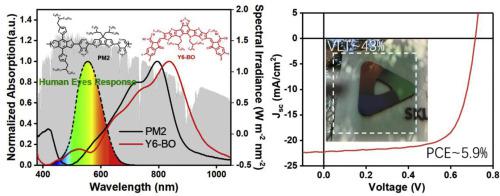Materials Today Energy ( IF 9.0 ) Pub Date : 2021-06-23 , DOI: 10.1016/j.mtener.2021.100807 T. Jiang , G. Zhang , R. Xia , J. Huang , X. Li , M. Wang , H.-L. Yip , Y. Cao

|
Recent advances in organic solar cells (OSCs) based on large-bandgap donors and low-bandgap non-fullerene acceptors (NFAs) have increased the power conversion efficiency (PCE) of OSCs to ~18%. However, these state-of-the-art OSCs have strong absorption in the visible region, limiting their application in semitransparent organic solar cells (STOSCs). In this study, an all-low-bandgap system based on a low-bandgap polymer donor (PM2) and a low-bandgap NFA (Y6-BO), was introduced as the light-harvesting layer for STOCSs with absorption mainly localized in the near-infrared (NIR) spectrum from 600 to 900 nm. The corresponding opaque OSCs exhibited the highest PCE among reported all-low-bandgap OSC systems, and the corresponding STOSCs showed higher visible light transmittances (VLTs) and light utilization efficiencies (LUEs) than the reference devices based on state-of-the-art PM6:Y6-BO OSC system with broad range absorption from visible to NIR. Optical simulations predicted that the PM2:Y6-BO-based STOSCs have a greater potential to realize higher VLTs and PCEs and better PCE retention (PCEsemitransparent/PCEopaque) than those from the PM6:Y6-BO-based STOSCs. Guided by these simulations, PM2-based STOSCs with VLTs exceeding 40% and PCEs of ~6% were achieved. Further recombination analysis suggested that the PM2-based devices experienced more severe charge recombination and energy losses, indicating there is further room for PCE improvement by designing new all-low-bandgap systems. Overall, this work shows the great potential of all-low-bandgap systems in realizing STOSCs with high PCEs and VLTs, which is promising for the commercialization of OSCs as power-generating window applications.
中文翻译:

基于全低带隙供体和受体材料的半透明有机太阳能电池及其性能潜力
基于大带隙供体和低带隙非富勒烯受体 (NFA) 的有机太阳能电池 (OSC) 的最新进展已将 OSC 的功率转换效率 (PCE) 提高到约 18%。然而,这些最先进的 OSC 在可见光区具有很强的吸收性,限制了它们在半透明有机太阳能电池 (STOSC) 中的应用。在这项研究中,基于低带隙聚合物供体(PM2)和低带隙 NFA(Y6-BO)的全低带隙系统被引入作为 STOCS 的光收集层,其吸收主要集中在600 至 900 nm 的近红外 (NIR) 光谱。在报告的全低带隙 OSC 系统中,相应的不透明 OSC 表现出最高的 PCE,和相应的 STOSC 显示出比基于最先进的 PM6:Y6-BO OSC 系统的参考器件更高的可见光透射率 (VLT) 和光利用效率 (LUE),具有从可见光到 NIR 的广泛吸收范围。光学模拟预测,基于 PM2:Y6-BO 的 STOSC 有更大的潜力实现更高的 VLT 和 PCE 以及更好的 PCE 保留率 (PCE半透明/PCE不透明)比来自基于 PM6:Y6-BO 的 STOSC 的那些。在这些模拟的指导下,实现了 VLT 超过 40% 和 PCE 超过 6% 的基于 PM2 的 STOSC。进一步的复合分析表明,基于 PM2 的设备经历了更严重的电荷复合和能量损失,表明通过设计新的全低带隙系统还有进一步改进 PCE 的空间。总的来说,这项工作显示了全低带隙系统在实现具有高 PCE 和 VLT 的 STOSCs 方面的巨大潜力,这对于 OSCs 作为发电窗口应用的商业化是有希望的。











































 京公网安备 11010802027423号
京公网安备 11010802027423号